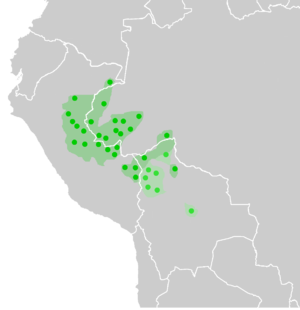| Takanan | |
|---|---|
| Geographic distribution | Bolivia |
| Linguistic classification | Pano–Tacanan?
|
| Glottolog | taca1255 |
 Takanan languages (light green) and Panoan languages (dark green). Spots indicate documented locations. | |
Tacanan is a family of languages spoken in Bolivia, with Ese’ejja also spoken in Peru. It may be related to the Panoan languages. Many of the languages are endangered.
Toromono is apparently extinct. Another possibly extinct Tacanan language is Mabenaro; Arasa has been classified as Tacanan, but appears to have more in common with Panoan.
Jolkesky (2016) notes that there are lexical similarities with the Kayuvava, Tupi, and Arawak language families due to contact.[1]
Below is a full list of Tacanan language varieties listed by Loukotka (1968), including names of unattested varieties.[2]
Loukotka (1968) lists the following basic vocabulary items for the Tacanan languages.[2]
| gloss | Tacana | Tumupasa | Isiama | Araona | Sapiboca | Maropa | Guacanahua | Mabenaro | Caviña | Toromona | Arasa | Tiatinagua |
|---|---|---|---|---|---|---|---|---|---|---|---|---|
| one | peada | peada | peáda | peada | pebbi | pembive | pea | nonchina | owi | |||
| two | beta | beta | beta | beta | beta | beta | béka | beta | béka | béta | bikapiai | |
| head | e-chua | e-shua | é-cho | e-chua | e-chuxa | e-chuxa | i-yoa | i-yuka | é-osha | é-osha | ||
| eye | e-tásha | é-tasha | ey-raha | e-sásha | é-shakuéna | i-thaha | i-xaka | e-shásh | é-shásha | i-sash | ||
| hand | e-me | ä-ma | e-me | e-me | e-mé | e-me | iá | i-miatsa | e-metuku | i-á | e-mä | e-mé |
| water | eavi | ahui | eahui | eavi | eubi | xubi | eowi | ena | ena | éna | ||
| fire | kuati | kuáti | kuáti | kuati | kuati | kuati | kuáti | kwathi | etiki | kuáti | chi | kuáti |
| sun | ideti | itaːti | itatti | izeti | iseti | icheti | igeti | huári | eshét | |||
| maize | dixe | oːtisha | ärishe | shíshe | chixe | shishé | ixike | shishé | shishe | shishi | ||
| tapir | ähuadi | aːhuadi | ahuáta | ahuánsha | auada | sháawi | shauví | |||||
| house | ete | äte | ete | etai | etae | étai | ithai | etare | ekíi | soːpo | eti |
Sample vocabulary of four Tacanan languages, along with Proto-Panoan for comparison, from Nikulin (2019):[3]
| gloss | Ese Ejja | Araona | Cavineña | Tacana | Proto-Panoan |
|---|---|---|---|---|---|
| liver | e-kakʷa | tákʷa | e-takʷa | e-takʷa | *takʷa |
| tongue | ej-ana | e-ána | j-ana | j-ana | *hana |
| blood | ami | ami | ami | *himi | |
| you (sg.) | mi-a | mi | mi- | mi | *mi |
| hand | e-me | e-me | e-me-tuku | e-me | *mɨ- |
| earth | meʃi | mezizo | metʃi ‘soil’ | med’i | *mai |
| meat | e-jami | e-ami | e-rami | j-ami ‘muscle’ | *rami |
| stone | mahana | makana | *maka | ||
| bone | e-sá | e-tsoa | e-tsau | e-tsau | *ʂao |
| (finger)nail | e-me-kiʃe | Ø-mé-tezi | e-me-tid’i | *mɨ̃-tsis | |
| fat | e-sei | e-tsei | e-tseri | e-tsei | *ʂɨ[n]i |
| tooth | e-sé | e-tse | e-tse | e-tse | *ʂɨta |